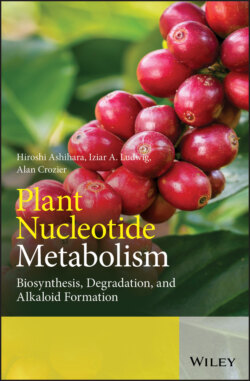Читать книгу Plant Nucleotide Metabolism - Hiroshi Ashihara - Страница 45
3.6 Nucleic Acid Biosynthesis
ОглавлениеDNA polymerases (DNA-directed DNA polymerase, EC 2.7.7.7) synthesize DNA from deoxyribonucleotides. These enzymes are essential for DNA replication and usually work in pairs to create two identical DNA strands from a single original DNA molecule. During this process, DNA polymerase ‘reads’ the existing DNA strand to create two new strands that match the existing one.
These enzymes catalyse the following chemical reaction:
DNA polymerase adds nucleotides to the 3′ end of a DNA strand, one nucleotide at a time. At least 15 classes of DNA polymerase have been identified in animals and terminal deoxyribonucleotidyl transferases. Based on their properties, the polymerases (α to σ) are classified into four families, A, B, X, and Y (Burgers et al. 2001). There are few papers on plant DNA polymerases although there is one which reports that plant DNA polymerase-γ is a DNA repair enzyme which functions in plant meristematic and meiotic tissues, and that it can substitute for Pol β and terminal deoxyribonucleotidyl transferase (Uchiyama et al. 2004).
Biosynthesis of RNA is catalysed by RNA polymerase (DNA-directed RNA polymerase, EC 2.7.7.6). The reaction is:
RNA polymerase, locally, opens the double-stranded DNA (usually about four turns of the double helix) so that one strand of the exposed nucleotides can be used as a template for the synthesis of RNA, namely transcription. A transcription factor and its associated transcription mediator complex must be attached to a DNA binding site, a promoter region, before RNA polymerase can initiate the DNA unwinding at that position. RNA polymerase has intrinsic helicase activity, therefore, no additional enzyme is required to unwind the DNA, in contrast to DNA polymerase. RNA polymerase, not only initiates RNA transcription, it also guides the nucleotides into position, facilitates attachment and elongation, has intrinsic proof reading and replacement capabilities, and a termination recognition function. In eukaryotes, RNA polymerase can build chains as long as 2.4 million nucleotides.
Plants have multiple types of nuclear RNA polymerase, each responsible for synthesis of a distinct subset of RNA. All are structurally and mechanistically related to each other and to bacterial RNA polymerase.
RNA polymerase I synthesizes a pre-rRNA 45S (35S in yeast), which matures into 28S, 18S, and 5.8S rRNAs that form the major RNA sections of the ribosome (Grummt 1998). RNA polymerase II synthesizes precursors of mRNAs and most small nuclear RNA (snRNA) and microRNA (miRNA) (Lee et al. 2004). RNA polymerase III synthesizes tRNAs, rRNA 5S and other small RNAs found in the nucleus and cytosol (Willis 1993). RNA polymerase IV synthesizes small interfering RNA (siRNA) in plants (Herr et al. 2005). RNA polymerase V synthesizes RNAs involved in siRNA-directed heterochromatin formation in plants (Wierzbicki et al. 2009).
Eukaryotic chloroplasts contain a plastid-encoded RNA polymerase that structurally is very similar to bacterial RNA polymerase. Chloroplasts also contain a second, structurally unrelated nucleus-encoded RNA polymerase. Mitochondria contain a structurally- and mechanistically-unrelated RNA polymerase that is a member of the single-subunit RNA polymerase protein family.
